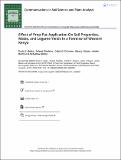| dc.contributor.author | Emily C Rutto, Robert Okalebo, Caleb O Othieno, Mary J Kipsat, Andre Bationo, Kefyalew Girma | |
| dc.date.accessioned | 2020-08-14T07:14:05Z | |
| dc.date.available | 2020-08-14T07:14:05Z | |
| dc.date.issued | 2011-11-01 | |
| dc.identifier.uri | https://repository.maseno.ac.ke/handle/123456789/2097 | |
| dc.description | High rates of soil depletion, food insecurity, and poverty are widespread in western Kenya, which calls for urgent and affordable solutions. A field experiment was carried out during 2003 short rains and 2004 long rains in western Kenya to study the effectiveness of “PREP-PAC” on soil properties, maize (Zea mays L.), and legume yields of six maize–legume intercrops. The experiment was conducted in a randomized complete block design, with four replications and two levels of fertility (no fertilizer and PREP-PAC). The maize variety, cv ‘KSTP’ (94), was intercropped with six legume types, namely: Bambaranuts (Vigna subterranean L., Var. Dark brown), Soybean (Glycine max L., Var. TGX 14482E), Yellow grams (Vigna radiate L., local type), Groundnuts (Arachis hypogaea L., Var. Uganda red stripped), Beans (Phaseolus vulgaris L., Var. KK15), and Cowpeas (Vigna unguiculata L., Var. white type). The farm was … | en_US |
| dc.description.abstract | High rates of soil depletion, food insecurity, and poverty are widespread in western Kenya, which calls for urgent and affordable solutions. A field experiment was carried out during 2003 short rains and 2004 long rains in western Kenya to study the effectiveness of “PREP-PAC” on soil properties, maize (Zea mays L.), and legume yields of six maize–legume intercrops. The experiment was conducted in a randomized complete block design, with four replications and two levels of fertility (no fertilizer and PREP-PAC). The maize variety, cv ‘KSTP’ (94), was intercropped with six legume types, namely: Bambaranuts (Vigna subterranean L., Var. Dark brown), Soybean (Glycine max L., Var. TGX 14482E), Yellow grams (Vigna radiate L., local type), Groundnuts (Arachis hypogaea L., Var. Uganda red stripped), Beans (Phaseolus vulgaris L., Var. KK15), and Cowpeas (Vigna unguiculata L., Var. white type). The farm was characterized by low pH of 5.35, low soil available phosphorus (P) below the critical value of 10 mg P/kg, and generally low exchangeable cations. Results indicated a significant (P < 0.05) increase in soil pH, soil available P (P < 0.0001), maize and legume yields (P < 0.0001) throughout the cropping seasons. Intercrops with bambaranuts, beans, and groundnuts produced better legume yields compared to the rest of the legumes. Therefore, the authors of this study concluded that, PREP-PAC is effective with elevated N input (60 kg N ha−1) on restoring soil fertility and improving farm productivity in western Kenya. However, availability and accessibility of PREP-PAC in local markets needs to be improved. | en_US |
| dc.publisher | Taylor & Francis Group | en_US |
| dc.subject | Maize and legume yields, PREP-PAC, soil available P | en_US |
| dc.title | Effect of PREP-PAC application on soil properties, maize, and legume yields in a Ferralsol of Western Kenya | en_US |
| dc.type | Article | en_US |

